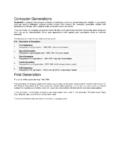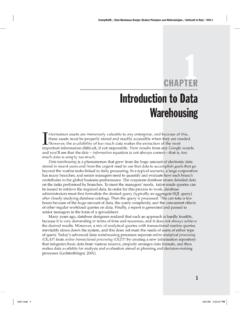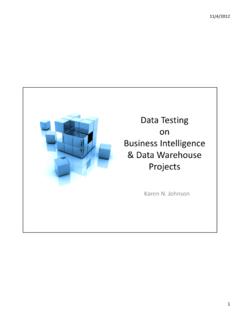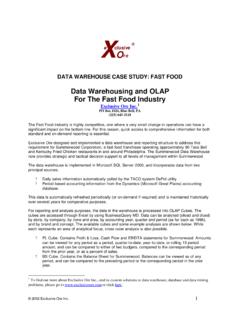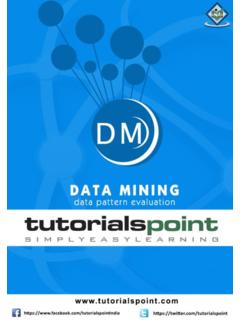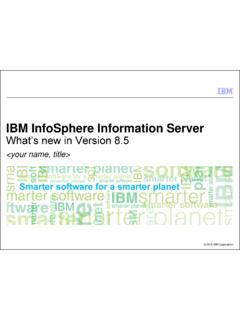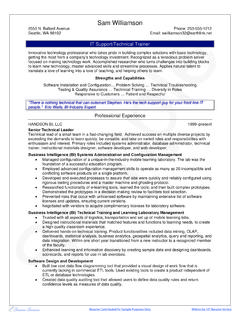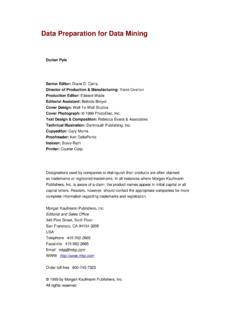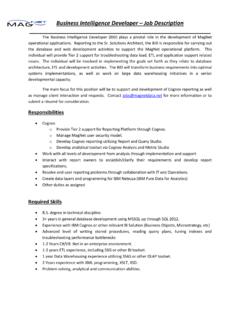Transcription of SQLAuthority.com - Data Warehousing Interview Questions ...
1 1 Copyright 2000-2008 Pinal Dave. All Rights Reserved. INDEX data Warehousing Interview Questions and Answers 1 data Warehousing Interview Q and Answers .. 2 Notice: All rights reserved worldwide. No part of this book may be reproduced or copied or translated in any form by any electronic or mechanical means (including photocopying, recording, or information storage and retrieval) without permission in writing from the publisher, except for reading and browsing via the World Wide Web. Users are not permitted to mount this file on any network servers. For more information send email to: 2 Copyright 2000-2008 Pinal Dave. All Rights Reserved. data Warehousing Interview Questions & Answers What is data Warehousing ? A data warehouse is the main repository of an organization's historical data , its corporate memory.
2 It contains the raw material for management's decision support system. The critical factor leading to the use of a data warehouse is that a data analyst can perform complex queries and analysis, such as data mining, on the information without slowing down the operational systems (Ref:Wikipedia). data Warehousing collection of data designed to support management decision making. data warehouses contain a wide variety of data that present a coherent picture of business conditions at a single point in time. It is a repository of integrated information, available for queries and analysis. What is Business Intelligence (BI)? Business Intelligence (BI) refers to technologies, applications and practices for the collection, integration, analysis, and presentation of business information and sometimes to the information itself.
3 The purpose of business intelligence is to support better business decision making. Thus, BI is also described as a decision support system (DSS). BI systems provide historical, current, and predictive views of business operations, most often using data that has been gathered into a data warehouse or a data mart and occasionally working from operational data . What is Dimension table? Dimensional table contains textual attributes of measurements stored in the facts tables. Dimensional table is a collection of hierarchies, categories and logic which can be used for user to traverse in hierarchy nodes. What is Dimensional Modeling? Dimensional data model concept involves two types of tables and it is different from the 3rd normal form. This concept uses Facts table which contains the measurements of the business and Dimension table which contains the context (dimension of calculation) of the measurements.
4 What is Fact table? Fact table contains measurements of business process. Fact table contains the foreign keys for the dimension tables. Example, if you are business process is "paper production", "average production of paper by one machine" or "weekly production of paper" will be considered as measurement of business process. 3 Copyright 2000-2008 Pinal Dave. All Rights Reserved. What are fundamental stages of data Warehousing ? There are four different fundamental stages of data Warehousing . Offline Operational Databases: data warehouses in this initial stage are developed by simply copying the database of an operational system to an off line server where the processing load of reporting does not impact on the operational system's performance.
5 Offline data warehouse : data warehouses in this stage of evolution are updated on a regular time cycle (usually daily, weekly or monthly) from the operational systems and the data is stored in an integrated reporting oriented data structure Real Time data warehouse : data warehouses at this stage are updated on a transaction or event basis, every time an operational system performs a transaction ( an order or a delivery or a booking etc.) Integrated data warehouse : data warehouses at this stage are used to generate activity or transactions that are passed back into the operational systems for use in the daily activity of the organization. (Reference :Wikipedia) What are the Different methods of loading Dimension tables? There are two different ways to load data in dimension tables.
6 Conventional (Slow): All the constraints and keys are validated against the data before, it is loaded, this way data integrity is maintained. Direct (Fast): All the constraints and keys are disabled before the data is loaded. Once data is loaded, it is validated against all the constraints and keys. If data is found invalid or dirty it is not included in index and all future processes are skipped on this data . Describes the foreign key columns in fact table and dimension table? Foreign keys of dimension tables are primary keys of entity tables. Foreign keys of facts tables are primary keys of Dimension tables. What is data Mining? data Mining is the process of analyzing data from different perspectives and summarizing it into useful information.
7 4 Copyright 2000-2008 Pinal Dave. All Rights Reserved. What is the difference between view and materialized view? A view takes the output of a query and makes it appear like a virtual table and it can be used in place of tables. A materialized view provides indirect access to table data by storing the results of a query in a separate schema object. What is OLTP? OLTP is abbreviation of On Line Transaction Processing. This system is an application that modifies data the instance it receives and has a large number of concurrent users. What is OLAP? OLAP is abbreviation of Online Analytical Processing. This system is an application that collects, manages, processes and presents multidimensional data for analysis and management purposes. What is the difference between OLTP and OLAP?
8 data Source OLTP: Operational data is from original data source of the data OLAP: Consolidation data is from various sources. Process Goal OLTP: Snapshot of business processes which does fundamental business tasks OLAP: Multi dimensional views of business activities of planning and decision making Queries and Process Scripts OLTP: Simple quick running queries ran by users. OLAP: Complex long running queries by system to update the aggregated data . Database Design OLTP: Normalized small database. Speed will be not an issue due to smaller database and normalization will not degrade performance. This adopts entity relationship(ER) model and an application oriented database design. OLAP: De normalized large database. Speed is issue due to larger database and de normalizing will improve performance as there will be lesser tables to scan while performing tasks.
9 This adopts star, snowflake or fact constellation mode of subject oriented database design. Back up and System Administration OLTP: Regular Database backup and system administration can do the job. OLAP: Reloading the OLTP data is good considered as good backup option. 5 Copyright 2000-2008 Pinal Dave. All Rights Reserved. What are normalization forms? There are different types of normalization forms like, 1NF: Eliminate Repeating Groups Make a separate table for each set of related attributes, and give each table a primary key. Each field contains at most one value from its attribute domain. 2NF: Eliminate Redundant data If an attribute depends on only part of a multi valued key, remove it to a separate table. 3NF: Eliminate Columns Not Dependent On Key If attributes do not contribute to a description of the key, remove them to a separate table.
10 All attributes must be directly dependent on the primary key BCNF: Boyce Codd Normal Form If there are non trivial dependencies between candidate key attributes, separate them out into distinct tables. 4NF: Isolate Independent Multiple Relationships No table may contain two or more 1:n or n:m relationships that are not directly related. 5NF: Isolate Semantically Related Multiple Relationships There may be practical constrains on information that justify separating logically related many to many relationships. ONF: Optimal Normal Form A model limited to only simple (elemental) facts, as expressed in Object Role Model notation. DKNF: Domain Key Normal Form A model free from all modification anomalies. Remember, these normalization guidelines are cumulative.

